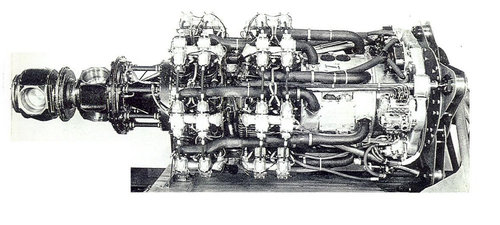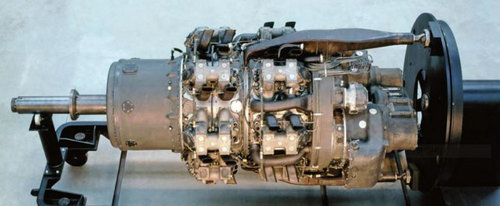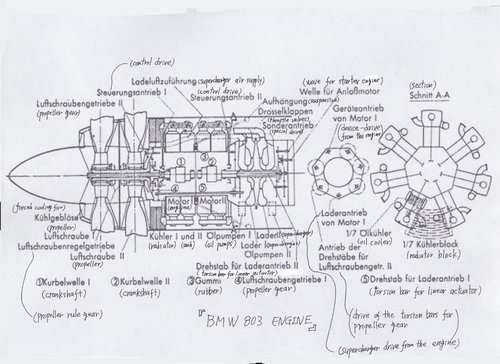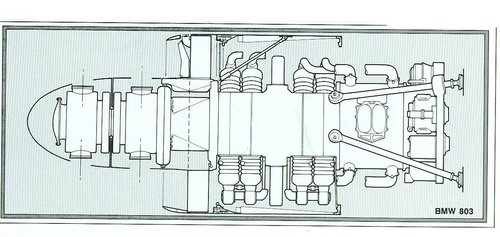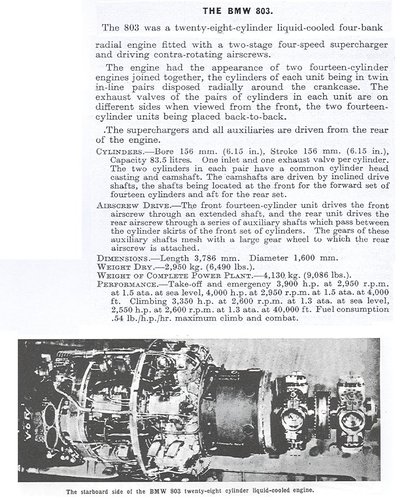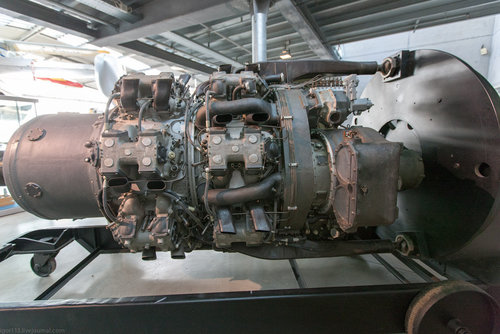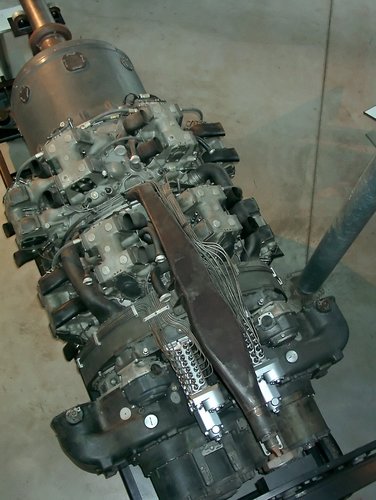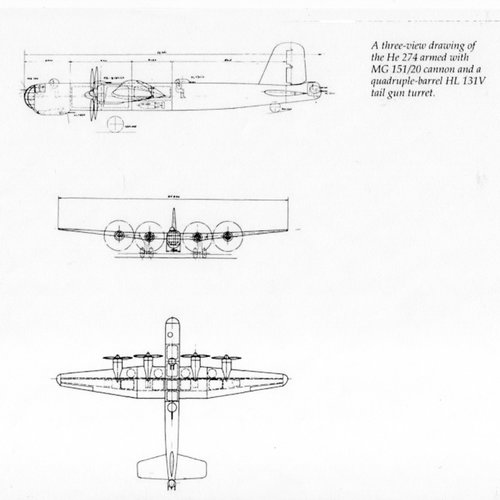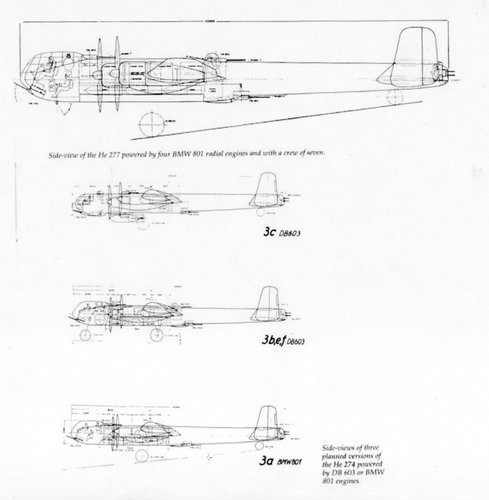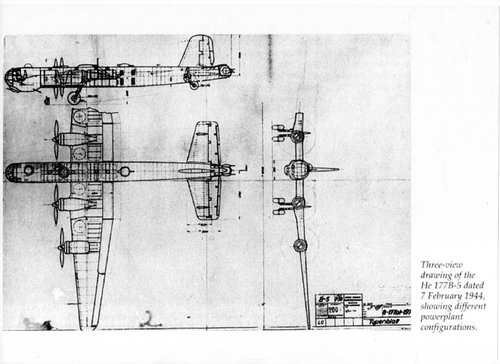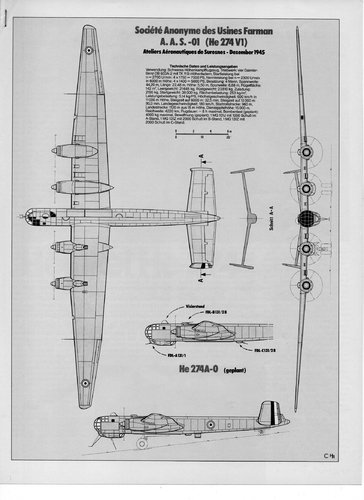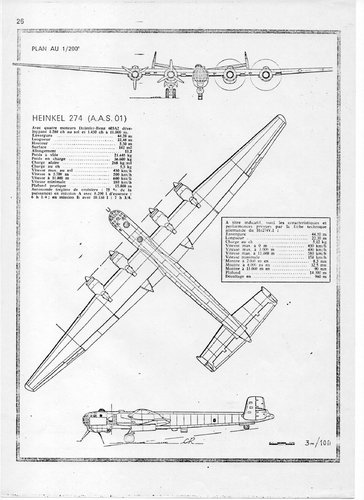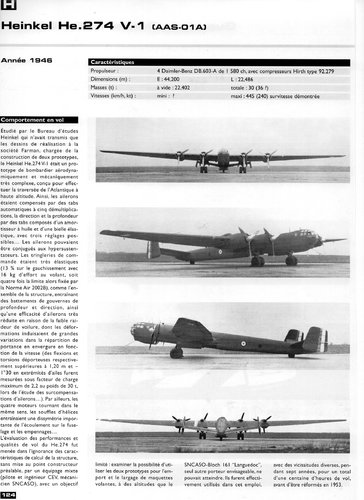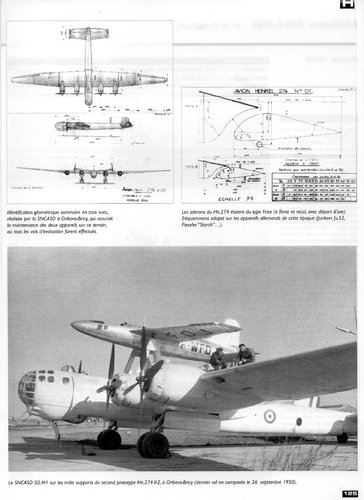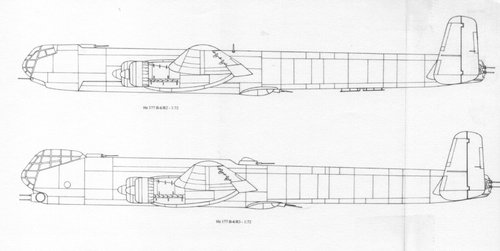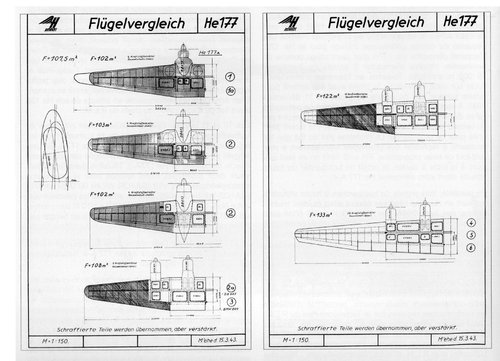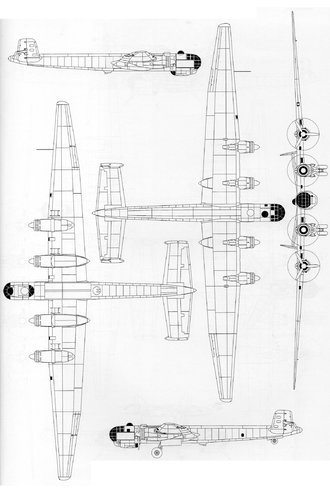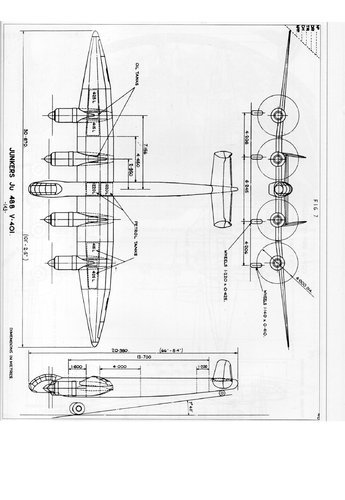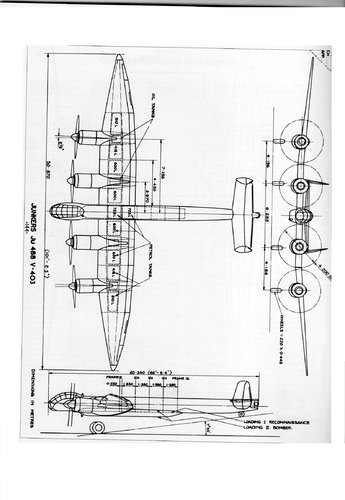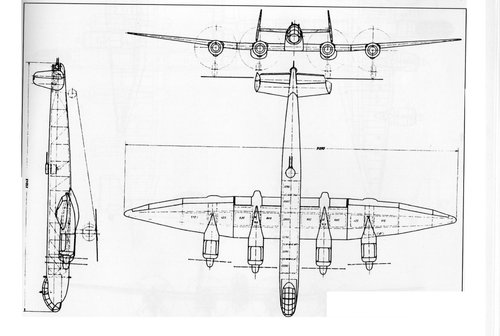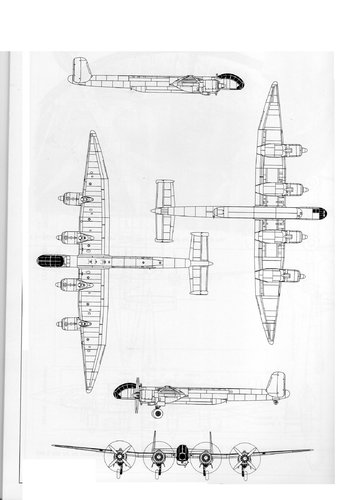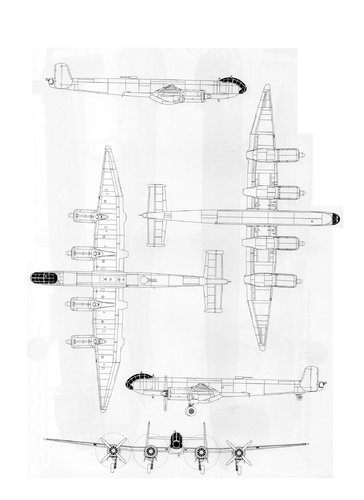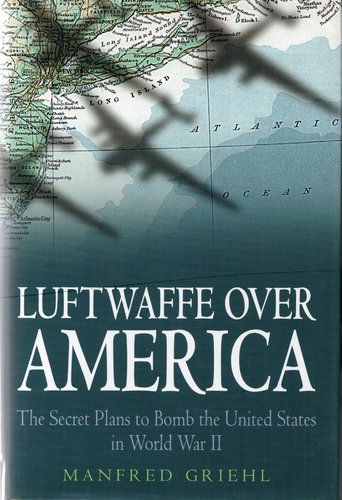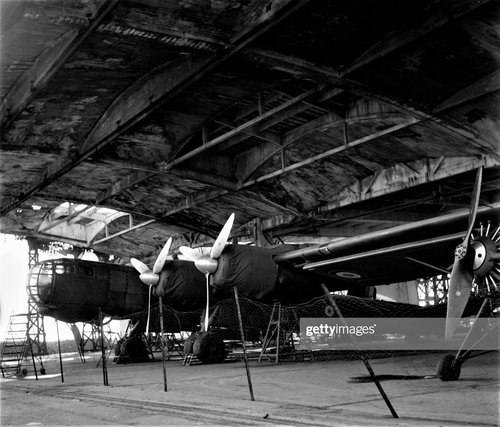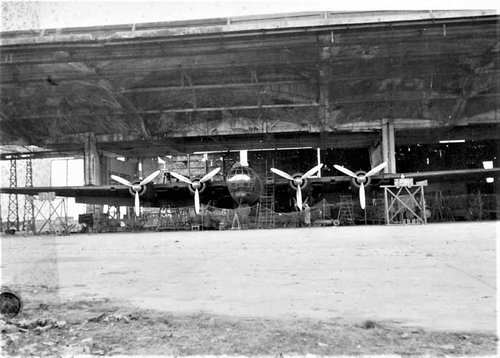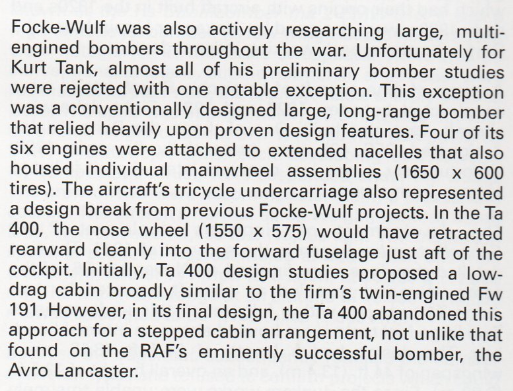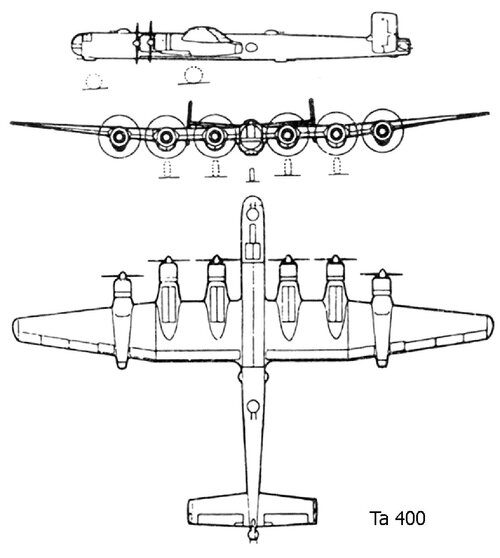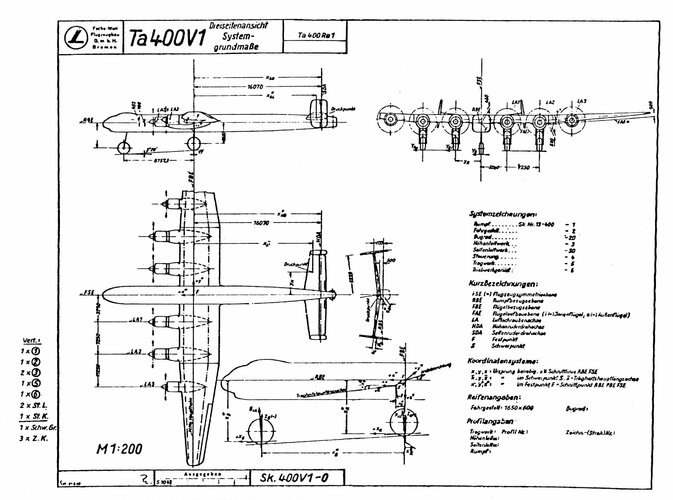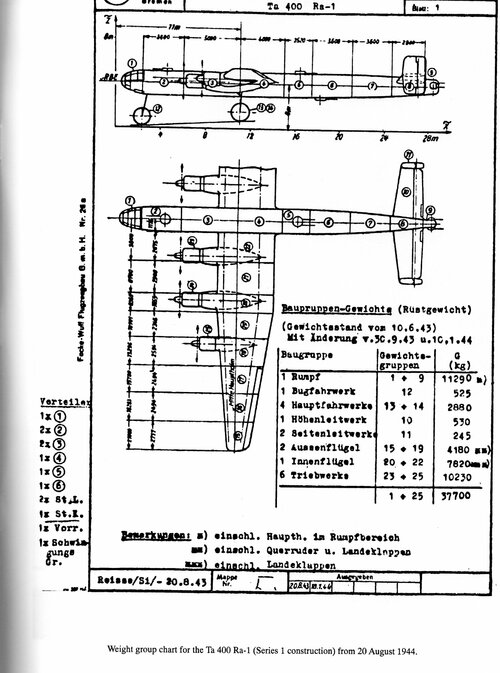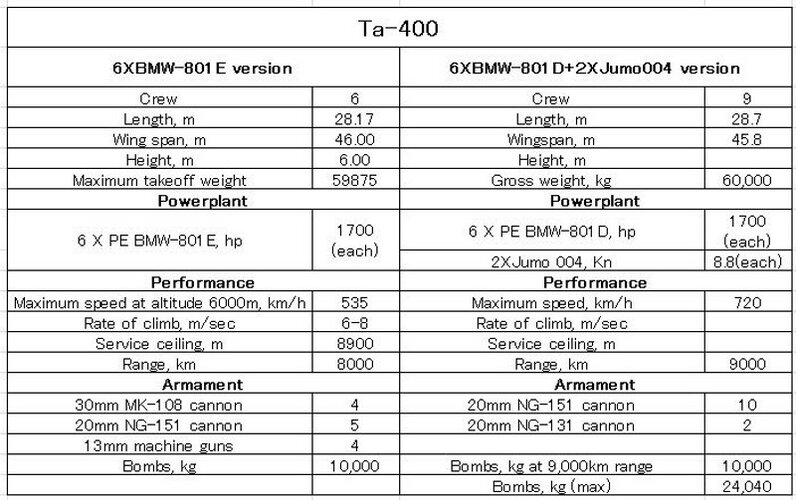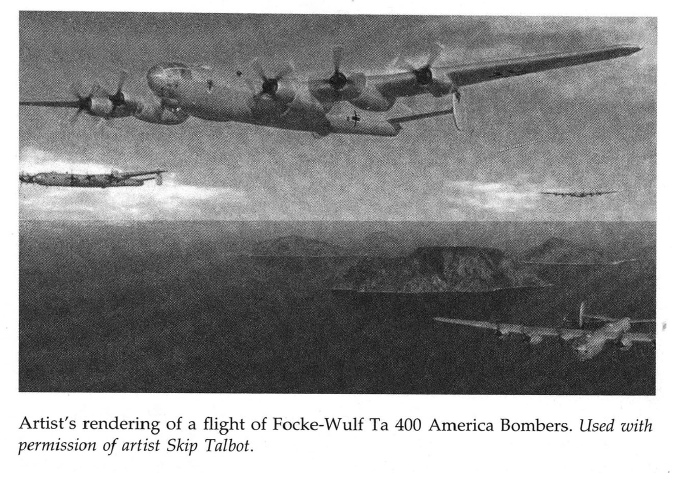You are using an out of date browser. It may not display this or other websites correctly.
You should upgrade or use an alternative browser.
You should upgrade or use an alternative browser.
Amerika Bomber: Me-264, Ta-400 and others
- Thread starter ysi_maniac
- Start date
- Joined
- 11 June 2014
- Messages
- 1,541
- Reaction score
- 2,899
Re: Focke-Wulf Ta 400
You mean the tail gunner position? The report says it's a manned Borsig HL 131 V turret with 4 x MG 131.
Wurger said:Thank you so much for the input. Does the accompanying text (if there is one, as usual) mentions the remote control stations? That battery of 2x2 Mk108`s would be smashing...
You mean the tail gunner position? The report says it's a manned Borsig HL 131 V turret with 4 x MG 131.
Re: Focke-Wulf Ta 400
I mean the chin turret(s), which I believe to be 2x2. The 0310225-20 drawing shows a control column, possibly an hydraulic-electric FA (Fernantrieb) remote control system I cannot recognize (there were at least 15 references, with some variants).
I mean the chin turret(s), which I believe to be 2x2. The 0310225-20 drawing shows a control column, possibly an hydraulic-electric FA (Fernantrieb) remote control system I cannot recognize (there were at least 15 references, with some variants).
- Joined
- 11 June 2014
- Messages
- 1,541
- Reaction score
- 2,899
Re: Focke-Wulf Ta 400
From an unnumbered brochure-type image:

Detail from drawing 0310 224-52:

Wurger said:I mean the chin turret(s), which I believe to be 2x2. The 0310225-20 drawing shows a control column, possibly an hydraulic-electric FA (Fernantrieb) remote control system I cannot recognize (there were at least 15 references, with some variants).
From an unnumbered brochure-type image:

Detail from drawing 0310 224-52:

Re: Focke-Wulf Ta 400
Great! What a powerful battery it would be...I recall a triple chin Mk103 turret intended for a Heinkel heavy bomber, aimed through periscopic means. It`s interesting to compare the electrical US turrets with the hydraulic german ones.
Great! What a powerful battery it would be...I recall a triple chin Mk103 turret intended for a Heinkel heavy bomber, aimed through periscopic means. It`s interesting to compare the electrical US turrets with the hydraulic german ones.
- Joined
- 25 June 2009
- Messages
- 14,752
- Reaction score
- 6,141
Those Fw 300A blueprints are amazing. I have a feeling there was a third picture that you initially shared, newsdeskdan, but the link is apparently no longer working. Can you repost it? Thanks anyway!
- Joined
- 11 June 2014
- Messages
- 1,541
- Reaction score
- 2,899
Skyblazer said:Those Fw 300A blueprints are amazing. I have a feeling there was a third picture that you initially shared, newsdeskdan, but the link is apparently no longer working. Can you repost it? Thanks anyway!
Third one? I can't remember. What I can tell you is that the Fw 300A/Ta 400 was never intended to be an Amerika Bomber. It was for attacking Britain and shipping in the Atlantic - which is why there are so many drawings of it armed with Hs 293s etc. The only aircraft you could ever really say was designed with bombing America in mind was what became the Me 264. And I can't find a single reference to it as an 'Amerika Bomber'. Goring referred to it as an 'Amerika flugzeug' and I've got interrogated prisoners of war saying it was known as the 'USA bomber' or 'New York flugzeug' but the words 'Amerika' and 'Bomber' do not seem to appear together in any contemporary source.
The earliest mention I can find of 'Amerika Bomber' is in an American magazine printed in 1952, and it uses 'Amerika bomber' to refer to the Junkers EF132. In the 1970s 'Amerika Bomber' is usually used to refer to the Me 264, in the 1980s it tends to be used in connection with the Sanger rocket bomber, in the 1990s it refers to the Horten XVIII and in the 2000s and on it refers to the Me 264 again. You can see how the whole 'Amerika Bomber' myth grew up...
- Joined
- 25 June 2009
- Messages
- 14,752
- Reaction score
- 6,141
newsdeskdan said:Third one? I can't remember.
The reason I said this is because the first of your three attachments in that post that wouldn't be displayed at the time. Now it's showing. Lousy wi-fi I guess...
newsdeskdan said:What I can tell you is that the Fw 300A/Ta 400 was never intended to be an Amerika Bomber. It was for attacking Britain and shipping in the Atlantic - which is why there are so many drawings of it armed with Hs 293s etc. The only aircraft you could ever really say was designed with bombing America in mind was what became the Me 264. And I can't find a single reference to it has an 'Amerika Bomber'. Goring referred to it as an 'Amerika flugzeug' and I've got interrogated prisoners of war saying it was known as the 'USA bomber' or 'New York flugzeug' but the words 'Amerika' and 'Bomber' do not seem to appear together in any contemporary source.
The earliest mention I can find of 'Amerika Bomber' is in an American magazine printed in 1952, and it uses 'Amerika bomber' to refer to the Junkers EF132. In the 1970s 'Amerika Bomber' is usually used to refer to the Me 264, in the 1980s it tends to be used in connection with the Sanger rocket bomber, in the 1990s it refers to the Horten XVIII and in the 2000s and on it refers to the Me 264 again. You can see how the whole 'Amerika Bomber' myth grew up...
Fascinating account! Thanks a lot for this newsdeskdan. Especially appreciated in those rapidly changing times of digital information that can be posted, modified, continue to exist in cache form with mistakes, and so forth. Each day that passes by sadly looks more and more like Orwell's 1984 to me, not just the states snooping on people, but also the constant rewriting of history... :'( :'(
- Joined
- 11 June 2014
- Messages
- 1,541
- Reaction score
- 2,899
Skyblazer said:newsdeskdan said:Third one? I can't remember.
The reason I said this is because the first of your three attachments in that post that wouldn't be displayed at the time. Now it's showing. Lousy wi-fi I guess...
newsdeskdan said:What I can tell you is that the Fw 300A/Ta 400 was never intended to be an Amerika Bomber. It was for attacking Britain and shipping in the Atlantic - which is why there are so many drawings of it armed with Hs 293s etc. The only aircraft you could ever really say was designed with bombing America in mind was what became the Me 264. And I can't find a single reference to it has an 'Amerika Bomber'. Goring referred to it as an 'Amerika flugzeug' and I've got interrogated prisoners of war saying it was known as the 'USA bomber' or 'New York flugzeug' but the words 'Amerika' and 'Bomber' do not seem to appear together in any contemporary source.
The earliest mention I can find of 'Amerika Bomber' is in an American magazine printed in 1952, and it uses 'Amerika bomber' to refer to the Junkers EF132. In the 1970s 'Amerika Bomber' is usually used to refer to the Me 264, in the 1980s it tends to be used in connection with the Sanger rocket bomber, in the 1990s it refers to the Horten XVIII and in the 2000s and on it refers to the Me 264 again. You can see how the whole 'Amerika Bomber' myth grew up...
Fascinating account! Thanks a lot for this newsdeskdan. Especially appreciated in those rapidly changing times of digital information that can be posted, modified, continue to exist in cache form with mistakes, and so forth. Each day that passes by sadly looks more and more like Orwell's 1984 to me, not just the states snooping on poeple, but also the constant rewriting of history... :'( :'(
One could argue that with 'Amerika flugzeug', 'USA bomber' and 'New York flugzeug' all used in contemporary sources, someone somewhere must've referred to the Me 264 as an 'Amerika bomber'. It seems likely that the Focke-Wulf design commonly referred to as the 'Fw 238' (Focke-Wulf never called it that, nor did the RLM) was a competitor for the same requirement as the Me 264, and a Junkers design that no longer seems to exist too (although it was probably somewhere along the lines of the EF100 or something otherwise related to the Ju 290 family). These were the three 'Amerika flugzeug' designs. There seem to have been some far-fetched 'maybe if we had two-stage mid-air refuelling' or 'maybe if we conquered the Azores and turned them into a gigantic air base' or 'maybe if we refuelled a BV 222 from a submarine' ideas but these never received any serious consideration.
Once Messerschmitt was chosen as the winner of the 'Amerika' requirement, and subsequently disgraced when it emerged that its calculations on range were wrong, a new requirement for a multi-purpose long-range aircraft was issued with the Ju 390 emerging as the winner (against a revised, smaller 'Fw 238' and an unknown six-engined Heinkel design).
The earliest Fw 300A/Ta 400 designs don't appear until late 1942 - some six months after that. So the Fw 300A/Ta 400 never really competed against the likes of the Ju 390, but did compete against the He 277. Neither of them had anything to do with America.
The He 274 was definitely in a class of its own, being specifically designed to avoid fighters by flying at high altitude. Its range was relatively poor - just enough to get it to western Britain, or Scotland, and back - so there's no way that was an 'Amerika bomber' either.
Skyraider3D
Aviation Artist
Some wicked finds, Dan! B)
blackkite
Don't laugh, don't cry, don't even curse, but.....
- Joined
- 31 May 2007
- Messages
- 8,819
- Reaction score
- 7,716
blackkite
Don't laugh, don't cry, don't even curse, but.....
- Joined
- 31 May 2007
- Messages
- 8,819
- Reaction score
- 7,716
Upper picture correspond to these drawings.
Mechanical supercharger seems to be single stage.
There was a large gap between No.2 and No.3 engine cylinder row in the second drawing.
But there was no such a gap in the first drawing.
The first drawing shows that the fresh air ducts to supercharger seems to locate front end and back end of the supercharger.
And the supercharged air ducts to the engine cylinders seems to locate middle of the supercharger.
But the second drawing shows that the fresh air nozzles seems to locate middle of the supercharger.
And the supercharged air ducts to the engine cylinders seems to locate front end and back end of the supercharger same as #46 top picture.
Perhaps there were some designs for BMW803 engine.
This engine is pusher type with radiator cooling fan. I can't find fresh air duct which connected to supercharger.
Mechanical supercharger seems to be single stage.
There was a large gap between No.2 and No.3 engine cylinder row in the second drawing.
But there was no such a gap in the first drawing.
The first drawing shows that the fresh air ducts to supercharger seems to locate front end and back end of the supercharger.
And the supercharged air ducts to the engine cylinders seems to locate middle of the supercharger.
But the second drawing shows that the fresh air nozzles seems to locate middle of the supercharger.
And the supercharged air ducts to the engine cylinders seems to locate front end and back end of the supercharger same as #46 top picture.
Perhaps there were some designs for BMW803 engine.
This engine is pusher type with radiator cooling fan. I can't find fresh air duct which connected to supercharger.
Attachments
Last edited:
- Joined
- 11 June 2014
- Messages
- 1,541
- Reaction score
- 2,899
Although, none of the aircraft you show images of was ever intended to bomb America. Particularly the He 274, which was designed as a high-altitude bomber and only had a range of 2200 to 2500 miles. I believe that the He 177's range was even less. The Ju 488 was designed for anti-shipping missions like the Fw 300A/Ta 400, rather than carrying a bomb load all the way to the US.
The original 'Amerika bomber' was the Me 264, although the RLM's calculations (in contrast to those of Messerschmitt) found that it didn't actually have the range to carry out that mission. Focke-Wulf and Junkers both designed 'Amerika' aircraft (as we have seen elsewhere on the forum recently with drawings of Focke-Wulf's 1941 Fernkampfflugzeug designs - Junkers' designs were the Ju 290 and 390) but they were much larger and heavier than the Me 264.
Incidentally, since I wrote those earlier posts in this thread back in 2016, I have discovered a single contemporary use of the phrase 'Amerika bomber' - used in reference to the Me 264.
Last edited:
- Joined
- 26 May 2006
- Messages
- 34,894
- Reaction score
- 15,758
- Joined
- 11 June 2014
- Messages
- 1,541
- Reaction score
- 2,899
Hi,
there was many multi-engined bomber Projects designed by Focke Wulf,
and before Ta.400,what was them ?.
Jet Planes of the Third Reich - The Secret Projects-volume two
Most of them are in my Luftwaffe: Secret Bombers bookazine - with a couple of notable exceptions that I've discovered since. They'll be going in the book.
blackkite
Don't laugh, don't cry, don't even curse, but.....
- Joined
- 31 May 2007
- Messages
- 8,819
- Reaction score
- 7,716
Hi! Ta-400.
https://airpages.ru/eng/lw/ta400.shtml
Three side view drawing shows Ta 400 powered by six BMW 801D radial engines, and later added two Jumo 004 jet engines.
https://airpages.ru/eng/lw/ta400.shtml
Three side view drawing shows Ta 400 powered by six BMW 801D radial engines, and later added two Jumo 004 jet engines.
Specification | |
Crew | 6 |
Dimensions | |
Wing span, m | 46.00 |
Length, m | 28.17 |
Height, m | 6.00 |
Powerplant | |
6 X PE BMW-801E, hp | 1700 |
Weight, kg: | |
Maximum takeoff weight | 59875 |
Performance | |
Maximum speed at altitude 6000m, km/h | 535 |
Rate of climb, m/sek | 6-8 |
Service ceiling, m | 8900 |
Service range, m | 8000 |
Armament | |
4 × 30-mm MК-108 cannon, 5 × 20-mm MG-151 cannon, 4 × 13-mm machine guns, bombs, kg | 10000 |
Attachments
Last edited:
- Joined
- 11 June 2014
- Messages
- 1,541
- Reaction score
- 2,899
Ta 400
Note the change in cockpit shape between August and October 1943. There were a large number of other changes too - in armament, crew, undercarriage size, equipment, fuel tank capacity and distribution, bomb bay attachments and overall weight, even though the external dimensions remained constant.
- Joined
- 11 June 2014
- Messages
- 1,541
- Reaction score
- 2,899
For example......We need a comprehensive table for Ta-400.
The Ta 400 was changed incrementally throughout its development existence so it'd be difficult to produce a fully comprehensive table. The version with supplemental jet propulsion was only a cursory study - nearly all of the development work focused on the different aspects of the piston-engine version particularly - the cockpit, bomb bay, fuel tanks and turrets. There is more detail on changes to the chin turret alone than there is on the entire supplemental jet version.
Airborne2001
ACCESS: Secret
- Joined
- 19 June 2020
- Messages
- 224
- Reaction score
- 278
Honestly makes one wonder why Germany would put so much resources into something so big that has a main role of attacking shipping. A modified Me-261 would have been a far better choice.Skyblazer said:Those Fw 300A blueprints are amazing. I have a feeling there was a third picture that you initially shared, newsdeskdan, but the link is apparently no longer working. Can you repost it? Thanks anyway!
Third one? I can't remember. What I can tell you is that the Fw 300A/Ta 400 was never intended to be an Amerika Bomber. It was for attacking Britain and shipping in the Atlantic - which is why there are so many drawings of it armed with Hs 293s etc.
Bearing that in mind, it also brings one to question why there never was an intention for the Ta-400 to be an intercontinental bomber...
- Joined
- 11 June 2014
- Messages
- 1,541
- Reaction score
- 2,899
Honestly makes one wonder why Germany would put so much resources into something so big that has a main role of attacking shipping. A modified Me-261 would have been a far better choice.
Bearing that in mind, it also brings one to question why there never was an intention for the Ta-400 to be an intercontinental bomber...
The Me 261 was never designed for carrying weaponry nor for the installation of defensive turrets. Strengthening its structure, fitting it with turrets, armour etc. would have resulted in a different aircraft - the Me 264, in fact - which was intended to be an intercontinental bomber.
At the point when the Ta 400 was designed, in early 1943, the GL had decided to discontinue all attempts to build a bomber with intercontinental range - because it was deemed that the distance to be covered was simply too great without air-to-air refuelling, and it was further decided that it was too difficult to make air-to-air refuelling work reliably.
But all the big aircraft were proposed for the anti-shipping/long-range reconnaissance 'fernaufklaerer' role - the Ta 400, Me 264, Ju 290, Ju 390, BV 238, BV 250 and the various He 177 developments (though not the He 274, because that was designed for altitude, not range). It was clear to the Germans that finding and destroying convoys going to and from Britain would severely curtail the Allies' resources - and it was a job that was entirely feasible, whereas the 'Amerika bomber' relied heavily on mathematical calculations in which nobody had much faith.
Airborne2001
ACCESS: Secret
- Joined
- 19 June 2020
- Messages
- 224
- Reaction score
- 278
I agree with this. Even the US could not get a true intercontinental bomber into service until the postwar period. Britain (and the Urals) were far more realistic choices for Germany.Honestly makes one wonder why Germany would put so much resources into something so big that has a main role of attacking shipping. A modified Me-261 would have been a far better choice.
Bearing that in mind, it also brings one to question why there never was an intention for the Ta-400 to be an intercontinental bomber...
The Me 261 was never designed for carrying weaponry nor for the installation of defensive turrets. Strengthening its structure, fitting it with turrets, armour etc. would have resulted in a different aircraft - the Me 264, in fact - which was intended to be an intercontinental bomber.
At the point when the Ta 400 was designed, in early 1943, the GL had decided to discontinue all attempts to build a bomber with intercontinental range - because it was deemed that the distance to be covered was simply too great without air-to-air refuelling, and it was further decided that it was too difficult to make air-to-air refuelling work reliably.
But all the big aircraft were proposed for the anti-shipping/long-range reconnaissance 'fernaufklaerer' role - the Ta 400, Me 264, Ju 290, Ju 390, BV 238, BV 250 and the various He 177 developments (though not the He 274, because that was designed for altitude, not range). It was clear to the Germans that finding and destroying convoys going to and from Britain would severely curtail the Allies' resources - and it was a job that was entirely feasible, whereas the 'Amerika bomber' relied heavily on mathematical calculations in which nobody had much faith.
Btw, thanks for your in depth responses and debunking. I never truly realized just how many fallacies existed with so many highly discussed types...
T. A. Gardner
ACCESS: Top Secret
- Joined
- 18 February 2021
- Messages
- 1,151
- Reaction score
- 2,021
Even if the Germans chose to build one of the Amerika bombers and did so early on in the war, the number finished would likely be countable on your fingers. Look at say Ju 290 production. This amounted to about an aircraft a month, maybe two. The German aircraft industry just wasn't up to mass producing a large four or six engine bomber.
All they could do was turn out a few handmade prototypes and if put into production make say a few a month at most. It would have take a year to get enough in service to outfit a squadron and then production would be mostly replacements for that squadron.
If you look at FW 200 Condor production, the Luftwaffe through the end of 1940 had about a dozen at most operational at any given time.
For the Germans they might manage one or two strikes on the US with this handful of bombers in say late 1942 or sometime in 1943 after which the next strike would be intercepted and that would be that. I could see this handful of bombers being hounded for hundreds of miles out into the Atlantic until every last one was shot down. All that effort for nothing gained on the German part.
All they could do was turn out a few handmade prototypes and if put into production make say a few a month at most. It would have take a year to get enough in service to outfit a squadron and then production would be mostly replacements for that squadron.
If you look at FW 200 Condor production, the Luftwaffe through the end of 1940 had about a dozen at most operational at any given time.
For the Germans they might manage one or two strikes on the US with this handful of bombers in say late 1942 or sometime in 1943 after which the next strike would be intercepted and that would be that. I could see this handful of bombers being hounded for hundreds of miles out into the Atlantic until every last one was shot down. All that effort for nothing gained on the German part.
Had they achieved a gun style fission device, a handful would be all that was needed. I have heard it said that Hitler thought it would be that—it would take the United States time to ramp up to wartime production…the 1970s. Also, they never really had a LeMay. The one advocate for heavy bombers died early, so they used those ugly glass-nosed twin engine jobs. Back when it was the WINGS channel, they showed light machine guns in one that looked to have less punch than some air rifles 
T. A. Gardner
ACCESS: Top Secret
- Joined
- 18 February 2021
- Messages
- 1,151
- Reaction score
- 2,021
To make that you need 98% enriched uranium 234. That in turn, requires masses of centrifuges or even more expensive electro-magnetic separators to achieve. Given that the US managed to make like two gun-type nuclear devices with a huge program using both methods, it is pretty much impossible that Germany could replicate the feat.Had they achieved a gun style fission device, a handful would be all that was needed. I have heard it said that Hitler thought it would be that—it would take the United States time to ramp up to wartime production…the 1970s. Also, they never really had a LeMay. The one advocate for heavy bombers died early, so they used those ugly glass-nosed twin engine jobs. Back when it was the WINGS channel, they showed light machine guns in one that looked to have less punch than some air rifles
The only realistic way for Germany to get to a nuclear device is to have one or more working reactors and discover plutonium like the US already had. That would allow for the development of an implosion device and give them a way to make sufficient fissile material to make bombs. Without plutonium, the US would have had maybe 6 to 8 bombs and that'd be that. The uranium 234 would be gone and no more bombs possible without a new source of unenriched uranium to cull more fissile material from.
Vahe Demirjian
I really should change my personal text
- Joined
- 28 February 2013
- Messages
- 815
- Reaction score
- 570
Photos of a wind tunnel model of the Focke-Wulf Ta 400 are available at this link:
 forum.warthunder.com
forum.warthunder.com
As Dan Sharp explains elsewhere in this forum, the Ta 400 and He 277 were only intended to attack Allied supply convoys in the Atlantic Ocean and did not have the range to strike the eastern US.
fw ta 400
Source: en.wikipedia.org/wiki/Focke-Wulf_Ta_400 The Focke-Wulf Ta 400 was a large six-engined bomber design developed in Nazi Germany in 1943 by Focke-Wulf as a serious contender for the Amerika Bomber project. One of the first aircraft to be developed from components from multiple countries, it...
As Dan Sharp explains elsewhere in this forum, the Ta 400 and He 277 were only intended to attack Allied supply convoys in the Atlantic Ocean and did not have the range to strike the eastern US.
- Joined
- 9 October 2009
- Messages
- 21,969
- Reaction score
- 13,616
Ivan Culjak
ACCESS: Confidential
- Joined
- 11 September 2021
- Messages
- 53
- Reaction score
- 53
With all respect, but what are you doing , the way you reasoning is actually applying today's knowledge on the past situation. Everything you say seems to be true but nobody, just nobody knew it in those days, not even the brightest generals and intelligence officers...Reality then and reality now are two different things..Re: Focke-Wulf Ta 400
SpicyJuan said:Excuse me if this comes off as rude, but perhaps you should read up more on the aircraft in question?
Actually, it was obvious that the Ta 400 would not be a worthwhile aircraft even by 1943.
Germany was losing air superiority in the East during 1943.
It had lost air superiority in the West, at home, and in the Med already.
By mid-1943 the failure of the Battle of the Atlantic was obvious.
The Me 264 had a substantial advantage in development time from the beginning.
4-engine derivations of the He 177 were bound to be available quickly if pursued.
Fuel supply was known to be unsatisfactory by 1943. Only fuel efficient (short range) bombers made much sense.
A shortage of aircraft mechanics plagued the Luftwaffe in 1943 to the point that only the most efficient aircraft designs made sense.
B-17 bombers were slaughtered without escorts over Germany in 1943, and the Ta 400's survivability against contemporary fighters (~1946/47) would have been abysmal.
Finally, something you did not mention in your timeline: The Ta 400 was an active program not only in 1943, but in 1944 as well.
The only thing that points against this being a project to keep development departments busy was the involvement of French engineers who wouldn't have been drafted anyway.
aviatorRicky
ACCESS: Restricted
- Joined
- 30 December 2021
- Messages
- 14
- Reaction score
- 16
He177 pilot Peter Brill born 1924, d.2013 gave a public lecture in Spain in 2005 about the Amerika bomber conversion of an He177 with wings grafted from the abandoned Me. 264 project and DB613 engines producing 3,800hp. Referred to as having 11,100km (5,993nm) range.I suppose no, but me-261 could be was adapted for this role ! :
But technically , there was me - 210 and me -410 with more range of Bf-110 ,
others was arado 240 as candidate !
Here coud be coming into an alternate history ....
:
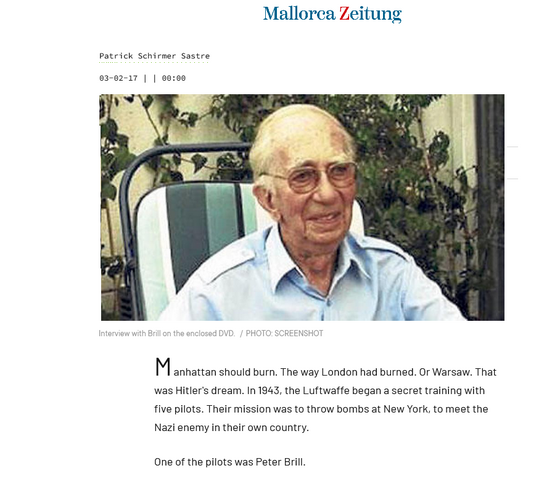
Last edited:
Similar threads
-
-
-
-
Messerschmitt Me 264 Variants and Projects
- Started by hesham
- Replies: 125
-
Heinkel He 177/277/274 Variants and Projects
- Started by Marcelo
- Replies: 128

